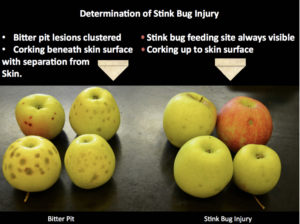With weird weather often comes weird physiological disorders (on top of our summer fruit rots). Often confused with hail injury, disease or insect damage, these physiological disorders are marring the appearance of many apples.
Symptoms of bitter pit include circular or even irregular sunken spots on the fruit surface, beneath brownish or streaked dead regions (Fig. 1). Note that the damage can be separated from the skin surface. Symptoms may be mistaken for hail damage, or any of the below problems. A key diagnostic feature is that hail usually affects only one side of the fruit, whereas bitter pit is more severe on blossom end of the fruit. Some varieties, like Honeycrisp, are more prone to this disorder, whereas hail will impact (literally) all varieties of fruit. Bitter pit can show up throughout the orchard, not just the edges.

Fig. 1. Bitter pit and lenticel rot often appear at the calyx end of the fruit. Photo by Janna Beckerman
Cork spot is another physiological disorder affecting outer portion of the fruit, and symptoms begin on the fruit flesh as small dimples or depressions. This disorder begins developing in June, and continues throughout the growth and enlargement of the apple. Lesions enlarge and develop 1/4 to 1/2 inch corky, discolored areas into the flesh of the apple. Unlike bitter pit, the corky spots may occur anywhere on the fruit flesh. It is important to note that all of these problems are only surface blemishes. Unfortunately, their unattractive appearance often reduces the marketability of the fruit.
Both disorders can be mistaken for brown marmorated stink bug injury (BMSB) (Fig. 2). BMSB usually appears around the edges of the orchard, although I do question their literacy skills and their ability to follow directions. BMSB can occur all over the apple, and more around the shoulder than the calyx. There should be a ‘sting’ in the center of the depression—this is a key diagnostic feature. Cornell has a really nice blog post by Peter Jentsch here: http://blogs.cornell.edu/jentsch/2014/09/18/bmsb-update-assessing-fruit-damage-at-harvest-is-it-hail-bitter-pit-apple-maggot-or-stink-bug/
You can perform preharvest sampling for bitter pit: Two weeks prior to harvest select large fruit and dip the fruit in a solution of 2,000 ppm ethephon in water (about 1 ½ teaspoons of ethephon to one gallon of water) to hasten the ripening. Hold the fruit for two weeks at room temperature. Should bitter pit develop, delay harvest for as long as possible, being sure to cool harvested fruit immediately, and delaying packing for as long as possible (preferably four weeks). During the delay, bitter pit will develop in the affected fruit, which can then be removed during the packing process.
For those that have had problems with these disorders: Bitter pit, cork spot and Jonathan spot are complex problem that require an integrated management scheme to reduce the problem to acceptable levels. It is very simple to say “just add more calcium” but the reality is more complex. Calcium isn’t as soluble as potassium or magnesium, making it less readily available to the plant. High levels of nitrogen, potassium, and magnesium compete with and reduce the fruit uptake of calcium. Furthermore, applications of nitrogen preferentially drive shoot growth over fruit growth, also reducing available calcium. Finally, high levels of available water can increase fruit calcium if shoot growth is not excessive, and drought prevents nutrient uptake that is needed to assure proper fruit development. That said, one study found, at least for ‘Honeycrisp’, the addition of calcium alone was beneficial (Rosenberger et al. 2004). Another nutrient issue on postharvest rots is excessive nitrogen use. Not only is judicious N use prudent to minimizing the risk of fire blight, but excessive N results in fruit that are predisposed to postharvest problems, compared to the lower N counterparts. Finally, in addition to ‘Honeycrisp,’ other susceptible varieties include ‘Baldwin,’ ‘Gravenstein,’ ‘Grimes Golden,’ and ‘Northern Spy.’ ‘Golden Delicious’ is considered moderately susceptible, while ‘Delicious’ and ‘Winesap’ are fairly resistant.
At this point, other than delayed harvest, all you can do is plan for next year. Bitter pit, cork spot and Jonathan spot can be remedied with calcium chloride at 2 pounds per 100 gallons of water (or 1.5 tablespoons per 1 gal. water) applied in four sprays beginning two weeks after full bloom and continuing at 10 to 14-day intervals thereafter to reduce cork spot. At this rate, calcium chloride may be added to pesticide sprays normally used in controlling post-bloom diseases (or insects) affecting fruit. Do NOT apply calcium chloride sprays when temperatures are above 85 degrees F. Calcium chloride is highly corrosive—be sure to rinse sprayer thoroughly after use. As nitrogen management is also implicated in this disease, reduce excessive shoot growth by not applying (or greatly minimizing) nitrogen to the soil of apple trees for at least one year. Evaluate results at the end of that season; in the second year, use ½ the recommended amount of N, and evaluate harvest again.
References and additional information:
Bitter pit control in apples. Available online at: http://www.omafra.gov.on.ca/english/crops/facts/00-009.htm
Rosenberger, D.A., J.R. Schupp , S.A. Hoying , L. Cheng, and C.B. Watkins. 2004. Controlling Bitter Pit in ‘Honeycrisp’ Apples. HortTechnology 14(3) 342-9.
http://horttech.ashspublications.org/content/14/3/342.full.pdf
